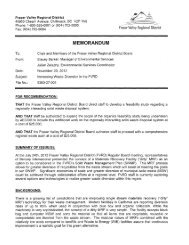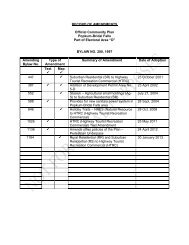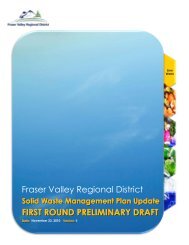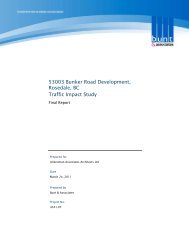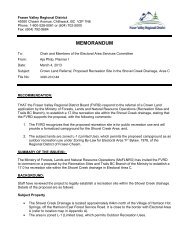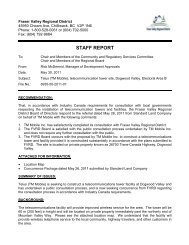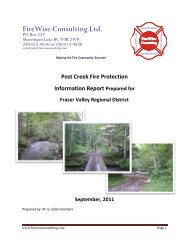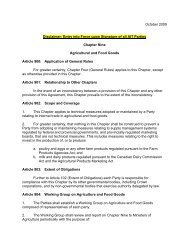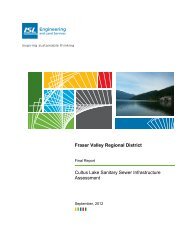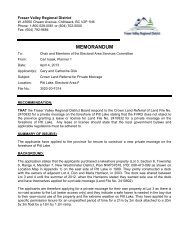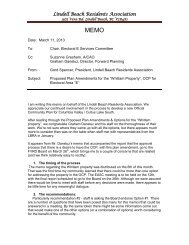Presentation of SUMA
Presentation of SUMA
Presentation of SUMA
You also want an ePaper? Increase the reach of your titles
YUMPU automatically turns print PDFs into web optimized ePapers that Google loves.
Humanitarian Supply Management<br />
System<br />
for natural and man made disaster situations<br />
1
Some chaos is an integral<br />
part <strong>of</strong> all disasters<br />
The mismanagement <strong>of</strong> the<br />
humanitarian assistance <strong>of</strong>ten<br />
leads to a<br />
‘secondary disaster’
Common scenario in a<br />
disaster...<br />
Fast mobilization <strong>of</strong> the donor community<br />
Massive arrival <strong>of</strong> international assistance<br />
OR<br />
No donor assistance<br />
Arrival <strong>of</strong> inappropriate, unsolicited<br />
supplies
A most usual scenario in this<br />
second phase <strong>of</strong> the<br />
disasters...
A recurrent scenario <strong>of</strong> a<br />
secondary disaster:<br />
Fast saturation <strong>of</strong> access points (airport,<br />
border, seaport…) ) with relief supplies<br />
Lack <strong>of</strong> a proper logistical system to<br />
manage the relief supplies:<br />
– receiving<br />
– warehousing<br />
– sorting<br />
– transport<br />
– distribution
A recurrent scenario <strong>of</strong> a<br />
secondary disaster:<br />
Warehouse space and means <strong>of</strong><br />
transportation are either scarce or not<br />
immediately available.<br />
Time is short and there is pressure from<br />
public opinion demanding the rapid<br />
distribution <strong>of</strong> the assistance.
A recurrent scenario <strong>of</strong> a<br />
secondary disaster:<br />
Loss <strong>of</strong> relief aid<br />
– Deteriorated products due to poor storage<br />
– Expiration dates<br />
– Material can not be sent, or is sent too late<br />
Offers from donors <strong>of</strong> important supplies<br />
are not adequately followed up
When humanitarian<br />
assistance<br />
becomes a problem!
When humanitarian assistance<br />
becomes a problem<br />
Aid hasn’t t been requested (unsolicited)<br />
Items are not appropriate for the country such as<br />
Clothing i.e.: winter clothes in the tropics<br />
Types <strong>of</strong> food i.e.: pork in a Muslim country<br />
May not be needed in present situation<br />
Parcels are not labeled / contents are unknown
When humanitarian assistance<br />
becomes a problem?<br />
Parcels contain:<br />
Different categories <strong>of</strong> supplies<br />
mixed in the same parcel (food,<br />
sanitary items, pharmaceuticals,<br />
clothing)<br />
Expired products (drugs, food)
When humanitarian assistance<br />
becomes a problem?<br />
There isn’t t a supply<br />
management system in place<br />
to deal with the incoming<br />
supplies
<strong>SUMA</strong><br />
Designed from the perspective <strong>of</strong><br />
the countries
Not only an electronic tool but a<br />
whole system for supplies<br />
management :<br />
Trained local staff<br />
Specific training and supportive<br />
materials<br />
S<strong>of</strong>tware to manage the information on<br />
relief supplies<br />
Flexibility: used for several types <strong>of</strong><br />
disasters, small or big emergencies
GRAPHIC OVERVIEW OF <strong>SUMA</strong><br />
DONORS<br />
Supplies<br />
POINTS OF ENTRY<br />
FIELD UNIT<br />
Information<br />
Government or NGOs<br />
Information <strong>of</strong> Needs,<br />
Pledges<br />
Supplies<br />
CENTRAL LEVEL<br />
Distribution<br />
at the point <strong>of</strong><br />
entry<br />
WAREHOUSES<br />
Distribution<br />
Information<br />
Information<br />
Supplies<br />
Local donations or purchases<br />
Reports<br />
Reports
The <strong>SUMA</strong> system allows<br />
authorities and humanitarian<br />
agencies to:<br />
Manage large quantities <strong>of</strong> relief supplies<br />
Record the flow <strong>of</strong> supplies (no “commodity<br />
tracking system”)<br />
Record pledges <strong>of</strong> donors and provide follow-up<br />
(national or international)<br />
Increase coordination and information sharing<br />
among all partners<br />
Demonstrate transparency and accountability
<strong>SUMA</strong> is about<br />
INFORMATION
What the <strong>SUMA</strong> system does?<br />
1. Registers<br />
2. Classifies<br />
3. Sorts<br />
4. Inventory<br />
5. Warehouse management
1. Registers<br />
Every shipment arriving in<br />
the country is registered by<br />
the system at a entry point
2. Classifies<br />
…incoming incoming supplies regardless<br />
<strong>of</strong> ownership<br />
What is it?<br />
A construction tool or a surgical<br />
piece <strong>of</strong> equipment?<br />
Pre-established categories OR<br />
Create new categories
3. Sorts<br />
…the supplies by assigning a<br />
level <strong>of</strong> priority<br />
Priority # 1 - Urgently Needed<br />
Priority #3 - Landfill?<br />
Priority #2 –<br />
Nice but can wait
4. Inventory<br />
…the items accordingly to:<br />
Technical features<br />
<strong>Presentation</strong> (syrup, tablets,<br />
ampoules …)<br />
Packing unit (bottles, boxes, bags...)<br />
Total quantities
5.Warehouse Management<br />
<strong>SUMA</strong> Stock Management Module<br />
- A module for warehouse<br />
inventory control
1. Registers: the donation received<br />
2. Classifies : what is it?<br />
3. Sorts : assigning a priority<br />
4. Inventory: how many?<br />
5. Warehouse<br />
management:<br />
controlling stock<br />
6. Pledges: follow up on <strong>of</strong>fered and<br />
assigned items
Provides snap shot <strong>of</strong> the flow <strong>of</strong> supplies<br />
at several stages<br />
Assists in inventory control within each<br />
agency<br />
Does not track a particular item from<br />
arrival to distribution (different from a<br />
control tracking system)
Who manages the<br />
<strong>SUMA</strong> system when<br />
a disaster occurs?
The <strong>SUMA</strong> Team<br />
Regional deployment teams (people<br />
and equipment)<br />
Trained local staff
The <strong>SUMA</strong> Team<br />
Technical personal previously trained<br />
with experience in supply management<br />
in emergency situations:<br />
– Volunteers health sector (practitioners,<br />
nurses, pharmacists)<br />
– Volunteers other sectors with logistical<br />
experience (customs, military forces)
Information gathered by the <strong>SUMA</strong><br />
system, belongs to whom?<br />
<strong>SUMA</strong> designed for<br />
local authorities to<br />
strengthen their<br />
capacity for a better<br />
disaster<br />
management.<br />
The information<br />
generated by <strong>SUMA</strong><br />
belongs to the<br />
recipient country.
<strong>SUMA</strong> IN THE<br />
AMERICAS
Adopted by all countries for<br />
various reasons:<br />
Technical contribution to logistics management<br />
Contribution to transparency and accountability to donors<br />
Unavailability <strong>of</strong> other affordable tools to register the<br />
incoming supplies<br />
Available free <strong>of</strong> charge<br />
Easy and flexible to use<br />
Technology requirements easily fulfilled in any region<br />
(hardware, basic communication system, diskettes)
<strong>SUMA</strong> IN THE AMERICAS<br />
Over 3.000 people have been trained<br />
in <strong>SUMA</strong> throughout the region<br />
including:<br />
National <strong>SUMA</strong> Teams<br />
Instructors who provide<br />
training in their own<br />
country and abroad<br />
Regional deployment<br />
teams (<strong>SUMA</strong> Response<br />
Team Caribbean)
<strong>SUMA</strong> IN THE AMERICAS<br />
The <strong>SUMA</strong> system is not only used for<br />
disaster supply management but also for<br />
routine warehousing operations:<br />
warehouses<br />
hospitals<br />
health districts
INSIDE THE REGION<br />
Argentina<br />
Barbados<br />
Bolivia<br />
Brazil<br />
Colombia<br />
Costa Rica<br />
Cuba<br />
Dominican Republic<br />
Ecuador<br />
El Salvador<br />
Eastern<br />
Caribbean<br />
Guatemala<br />
Haiti<br />
Honduras<br />
Mexico<br />
Nicaragua<br />
Panama<br />
Peru<br />
USA<br />
Venezuela
OUTSIDE THE REGION<br />
Afghanistan<br />
Armenia<br />
Bangladesh<br />
Bosnia<br />
East Timor<br />
France<br />
India<br />
Mozambique<br />
Rwanda<br />
Spain<br />
United Kingdom
<strong>SUMA</strong> BEING<br />
USED...
By the UN System:<br />
• Haiti humanitarian operation<br />
• UNDAC training (simulators)<br />
• WHO<br />
• UNICEF
By International NGO´s:<br />
• Red Cross Federation<br />
• MSF (Medicins(<br />
Sans Frontières<br />
res)<br />
• CARITAS<br />
• CARE<br />
Others:<br />
• CDERA<br />
• CEPREDENAC<br />
• European Union (ECHO)
Not just a computer<br />
program<br />
but an integral<br />
management and<br />
training system
<strong>SUMA</strong><br />
Foundation for the development and<br />
improvement <strong>of</strong> humanitarian supply<br />
management systems at global level<br />
39
<strong>SUMA</strong><br />
Satisfactory relationship for both parties:<br />
Response experience; opportune and<br />
good response<br />
Know-how in logistics<br />
Good volunteer networking (3000+<br />
volunteers: instructors, experts)<br />
40
<strong>SUMA</strong><br />
Training program:<br />
Training in application s<strong>of</strong>tware<br />
Integral Logistical Management <strong>of</strong><br />
Emergency Supplies<br />
41
<strong>SUMA</strong> ON INTERNET<br />
www.disaster-info.net/<strong>SUMA</strong><br />
info.net/<strong>SUMA</strong><br />
suma@paho.org<br />
42




